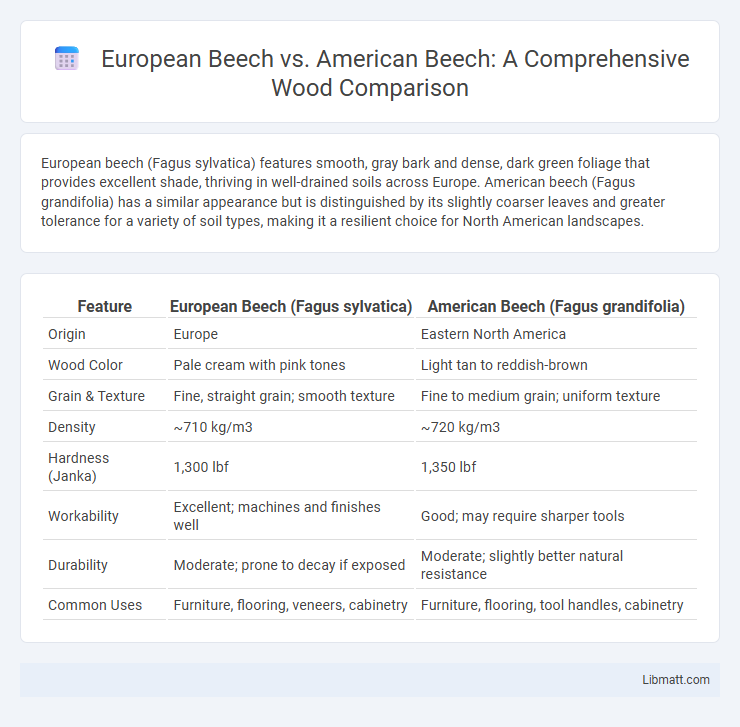European beech (Fagus sylvatica) features smooth, gray bark and dense, dark green foliage that provides excellent shade, thriving in well-drained soils across Europe. American beech (Fagus grandifolia) has a similar appearance but is distinguished by its slightly coarser leaves and greater tolerance for a variety of soil types, making it a resilient choice for North American landscapes.
Table of Comparison
| Feature | European Beech (Fagus sylvatica) | American Beech (Fagus grandifolia) |
|---|---|---|
| Origin | Europe | Eastern North America |
| Wood Color | Pale cream with pink tones | Light tan to reddish-brown |
| Grain & Texture | Fine, straight grain; smooth texture | Fine to medium grain; uniform texture |
| Density | ~710 kg/m3 | ~720 kg/m3 |
| Hardness (Janka) | 1,300 lbf | 1,350 lbf |
| Workability | Excellent; machines and finishes well | Good; may require sharper tools |
| Durability | Moderate; prone to decay if exposed | Moderate; slightly better natural resistance |
| Common Uses | Furniture, flooring, veneers, cabinetry | Furniture, flooring, tool handles, cabinetry |
Introduction: European Beech vs American Beech
European beech (Fagus sylvatica) features smooth, gray bark and broad, oval leaves with wavy edges, thriving in temperate European forests and valued for its dense, durable hardwood. American beech (Fagus grandifolia) exhibits slightly smaller leaves with sharper serrations and grows predominantly in eastern North American woodlands, prized for its smooth bark and resistance to cold climates. Your choice between these species depends on regional climate, soil conditions, and specific landscaping or woodworking needs.
Botanical Classification and Origins
European beech (Fagus sylvatica) and American beech (Fagus grandifolia) both belong to the Fagaceae family, sharing the genus Fagus but differing at the species level. European beech is native to the temperate forests of Europe, flourishing across central and southern regions, while American beech originates from eastern North America, primarily found in mixed hardwood forests of the United States and Canada. Understanding these botanical classifications and geographic origins helps you identify each species' ecological roles and adaptability.
Distinctive Physical Characteristics
European beech (Fagus sylvatica) features smooth, gray bark and ovate leaves with wavy margins, often larger and more glossy compared to American beech (Fagus grandifolia). American beech typically has sharper-toothed leaves with a more serrated edge and distinctive long, pointed buds, while its bark remains smooth but may develop a silvery sheen. You can identify these species by comparing leaf texture, margin shape, and bud morphology, which are key distinctive physical characteristics.
Growth Habits and Size Comparison
European beech (Fagus sylvatica) typically grows taller and broader, reaching heights of 50-70 feet with a dense, rounded canopy, whereas American beech (Fagus grandifolia) generally attains 40-60 feet with a more pyramidal shape and slightly narrower spread. Growth rates for European beech tend to be faster in optimal European climates, while American beech grows more slowly but is highly adaptable to various soil types in North America. Understanding these differences helps you select the best species for your landscape needs concerning space and growth speed.
Leaf Structure and Seasonal Changes
European beech leaves (Fagus sylvatica) feature a smooth, oval shape with wavy edges and prominent parallel veins, turning vibrant shades of copper and orange in autumn. American beech leaves (Fagus grandifolia) are sharply toothed with a more elongated form, displaying golden-yellow to bronze hues during fall. Both species exhibit deciduous behavior, shedding leaves in late autumn, but their distinct leaf morphology and pigmentation patterns are key identifiers.
Bark Texture and Color Differences
European beech (Fagus sylvatica) displays a smooth, silvery-gray bark with occasional light marks, maintaining a consistent texture throughout its trunk and branches. American beech (Fagus grandifolia) features similarly smooth bark but tends to have a slightly more silver to light gray color with subtle horizontal markings and occasional rough patches near the base. The bark of European beech appears more uniform and lighter, while American beech bark demonstrates variation in texture and a slightly darker hue.
Habitat Preferences and Geographic Distribution
European beech (Fagus sylvatica) thrives in temperate forests across central and western Europe, favoring well-drained, fertile soils and moderate climates with high humidity. American beech (Fagus grandifolia) is native to eastern North America, from Nova Scotia to northern Florida, preferring acidic, moist, and nutrient-rich soils in mixed hardwood forests. Understanding these habitat preferences helps you select the right species for reforestation or landscaping projects based on regional climate and soil conditions.
Timber Qualities and Commercial Uses
European beech (Fagus sylvatica) timber is hard, heavy, and exhibits fine, even grain, making it ideal for furniture, flooring, and plywood. American beech (Fagus grandifolia) shares similar hardness and density but is slightly less durable outdoors, favoring applications in cabinetry, tool handles, and veneer production. Both species offer excellent workability and finish, contributing to their widespread use in commercial woodworking industries across Europe and North America.
Ecological Roles and Wildlife Benefits
European beech (Fagus sylvatica) and American beech (Fagus grandifolia) both provide crucial ecological functions by supporting diverse wildlife habitats and contributing to forest nutrient cycling. European beech produces dense canopies that offer shelter for birds like tits and woodpeckers, while its nuts serve as food for small mammals such as squirrels and dormice. American beech supports a similar range of species, providing mast for deer, black bears, and various bird species, and its extensive root systems help stabilize soil and improve forest health.
Cultivation Tips and Landscape Suitability
European beech thrives in well-drained, fertile soils with partial to full sun, making it ideal for large parks and formal gardens due to its dense canopy and smooth bark. American beech prefers acidic, moist, and well-drained soils, tolerating more shade, which suits naturalistic landscapes and woodland edges. To maximize your cultivation success, select European beech for open spaces and American beech for shaded, forest-like settings to ensure healthy growth and landscape harmony.
European beech vs American beech Infographic

 libmatt.com
libmatt.com